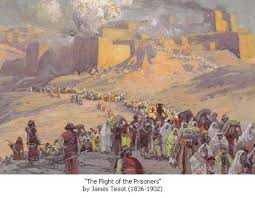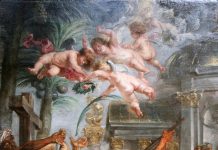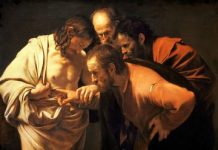The books of Ezra and Nehemiah are two of the lesser-known books of the Bible, but they are actually very important to understanding God’s plan of salvation, recounting the three waves in which the Jews returned to Judah from their exile in Babylon, which take place over the course of almost 100 years (538 BC – 444 BC).
The book of Ezra begins with King Cyrus, prompted by God, making a decree that the Jews should return to Judah and rebuild the Temple in Jerusalem. He even tells his own people that they should assist the Jews with silver, gold, and other necessities to complete the task, and he returns the vessels that were taken by Nebuchadnezzar from the former Temple. The next several chapters describe how Zerubbabel led the first wave of Jews back to Jerusalem and, despite opposition from those who had taken over the land, rebuilt the Temple. The book also makes reference to the importance of the prophetic ministry of Haggai and Zechariah during the time of rebuilding the Temple.
Following the completion of the Temple (537 BC), Ezra led the second wave of exiles back to Jerusalem. Ezra was a scribe, and he was well educated in the Law. Their journey was perilous because they were travelling without military escort, but Ezra emphasizes that through prayer, fasting, and trusting in the Lord they reached Jerusalem safely. Upon his return, Ezra begins the moral reform of the Jews. He condemns those who married gentile women and calls them to repentance. The fall of Israel began through Solomon’s infidelity to the law; therefore, if they hope to rebuild Israel, they must repent and become faithful to the law.
The third wave of exiles to return was led by Nehemiah. The book of Nehemiah begins by describing his return to Jerusalem and his recognition that God was calling him to lead the people in rebuilding the city walls. He became the governor of Jerusalem and, through obedience to God’s law and despite the opposition of many Jews and enemies of Jerusalem, he rebuilt the walls in 52 days, which was seen by all as a work of God.
The pairing of the reading from Nehemiah with Luke 4:14-21 on the 3rd Sunday in Ordinary Time reminds us that the fullest interpretation of these books is found in Christ Jesus, Who reads from Isaiah, The Spirit of the Lord is upon me, because he has anointed me to preach good news to the poor. He has sent me to proclaim release to the captives and recovery of sight to the blind, to set at liberty those who are oppressed, to proclaim the acceptable year of the Lord (Luke 4:18-19). The exile in Babylon is symbolic of the alienation from God that we experience when we sin. The sins of the Israelites were the cause of their physical exile, but, more importantly, their sins also destroyed their relationship with God. Jesus says, Today this Scripture has been fulfilled in your hearing (Lk 4:21). Jesus reconciles man to God, by bringing us out of our own spiritual exile, and the books of Ezra and Nehemiah show us the structure of that reconciliation.
The return from exile begins with the rebuilding of the Temple in Jerusalem. It is necessary to have a physical centre of prayer and worship that unites and focuses the religion of the people. Individual prayer in their own homes was insufficient to keep the Israelites faithful. They had to repent of having worshipped false idols and resume right religion. Likewise, when we sin, we are tempted to separate ourselves from the rites of the Church. If we are to return to the Lord, we must continue to pray and worship Him according to the rites that He has prescribed; namely, we must repent, go to confession, and resume going to Mass.
The second phase of the return from exile is to become re-acquainted with the Law and begin ascetical practices. The Jews had ceased studying the Word of God, and so they were ignorant of what God had taught them. They were also accustomed to trusting their own power instead of relying on the Lord. The same is true for those who fall into sin and depart from God’s ways. The return requires a discipline of prayer, fasting, and study. If we want to stay close to the Lord, we must know His Word and we must be disciplined. For us that means knowing Scripture and Tradition, and, through prayer and fasting, cultivating the soil of our heart and mind so that the Word will take root. Ignorance of the Bible and ignorance of the teachings that have been passed down to us through the Church is a sure path back into exile. We must know God in order to love Him, and in order to know Him, we must study His Self-Revelation in Scripture and Tradition.
The third phase of the return from exile is rebuilding the walls of Jerusalem. For the Jews, this was the most challenging aspect of the return. Many Jews and gentiles opposed Nehemiah’s efforts. The walls provoked fear because they indicated that the Jews wanted to separate themselves from everyone else. Many people interpreted the walls as a sign of aggression towards outsiders and subversion of imperial authority. Walls remain controversial today, and yet God is telling us that they are essential to the return from exile. Building walls means clearly defining an identity. In order to be Catholic, we must know what is Catholic and what is alien to Catholicism. Nehemiah makes clear that the walls aren’t an impenetrable barrier – there are gates! However, the gates are guarded and there is discretion regarding what is allowed in and out of the city. Being a true Catholic doesn’t mean totally closing ourselves off from outside influences, but it does mean being as vigilant as a soldier in guarding our hearts and minds against what is foreign to Christ and His Church.
Once again, Christ is the path from exile back to God. He is the New Temple – Through the Sacraments we enter the Temple and are united to Christ. He is the Word made flesh – Through prayer, fasting, and study, we come to know and love the Word. His bride, the Church, is the New Jerusalem – We must know what is and is not Catholic. The Apostle John says in Revelation, “[The New Jerusalem] had a great, high wall, with twelve gates, and at the gates twelve angels” (Rev 21:12). This is the structure of our return from exile.










